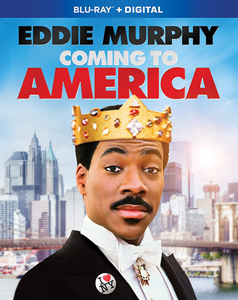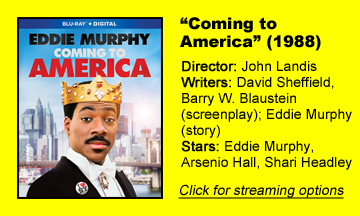“Coming to America” (1988), from the height of Eddie Murphy’s comedic powers, has returned to the spotlight thanks to the upcoming release of the sequel “Coming 2 America,” which hits Amazon Prime on March 5. The original remains a classic thanks to Murphy’s and Arsenio Hall’s ability to create so many funny caricatures within not only one movie, but within single scenes.
Strong and weak editing
Oddly, the editing is both a strength and weakness of director John Landis’ film (it would be purely a weakness in 1994’s “Beverly Hills Cop III”).
In the barbershop scenes, Murphy plays the black tall-tale-telling shop-owner and the white Jewish regular, and Hall plays another barber. So when Murphy’s African Prince Akeem and Hall’s servant Semmi visit, Murphy is playing three characters and Hall two, yet the sequences flow perfectly.
On a macro level, though, the film is notably loose. The joke-landing percentage in the screenplay by David Sheffield and Barry W. Blaustein is respectable, but the momentum isn’t sustained; it has to be restarted each time.
And when it doesn’t try for laughs – when it’s just the fathers (John Amos’ Cleo and James Earl Jones’ King Joffer) dealing with the logistics of their children’s locations in Queens – it lags further.
It’s not that “CTA” sets things up too broadly or mugs after the joke too long, but it doesn’t quite trust the audience to absorb the basic premise. Compare it to something like “The Naked Gun” from the same year, and it’s clear this film’s rhythm is off.
Surprisingly family friendly
Yet I liked “Coming to America.” Despite having risqué moments and a lot of swearing, this is a heartfelt, family friendly film. Its baseline comedy comes from the fish-out-of-water premise of a Zabundan prince – and a helper whose royal-court life is pretty easy, too – throwing themselves into the crappiest part of the Big Apple as Akeem searches for true love.
Then it adds on the idea that class status shouldn’t come between people who like each other – although this is a somewhat breezy notion. When Akeem suggests renouncing their throne at the end, bride Lisa (Shari Headley) thinks about it for a second, then says “Nah!”
“Coming to America” gets laughs from many sources. It has broad stereotype-based chuckles, like when love-struck Akeem happily sings in the streets and we hear variants on “Shut the f— up!” echo through the dirty brick corridors of Queens.
It has of-the-time humor, like the spray-dependent hairstyle of Lisa’s boyfriend Darryl (Eriq La Salle). It makes fun of Hollywood’s view of the USA: “The land is so big. The choices so infinite. Where shall we go, Los Angeles or New York?”
Hollywood’s version of Africa
And it hits on cultural stereotypes. The African dance sequence that precedes the reveal of the wife who has been picked out for Akeem goes on so long that – in this case – I’m sure that’s part of the joke. (It’s also incredibly choreographed, with gorgeous costumes, so it’s engaging on that level, too.)

But I sense “CTA” is making fun of stereotypes of African culture rather than making fun of African culture. This feeling comes from the fact that the conflicts are universal: Both Akeem’s and Lisa’s parents want good lives for their children but have trouble understanding what their children want.
I doubt the filmmakers did a deep dive into African culture during pre-production. The Africans speak clear English, except with an “African” accent, and it’s only minor things that reveal culture gaps, such as Akeem not knowing that “f*** you” is an insult rather than a friendly greeting.
“CTA” generally sees human behavior as universally predictable: At the wedding-announcement ceremony in Africa, a T-shirt seller hawks his wares outside the palace.
The central delights of “Coming to America,” though, are Murphy and Hall (whose Reverend Brown is a particular blast), who seem to have fun making it. But I think there’s a real possibility the sequel could be funnier, as the core actors return and they now have the differences between 1988 and 2021 America to poke fun at too.


